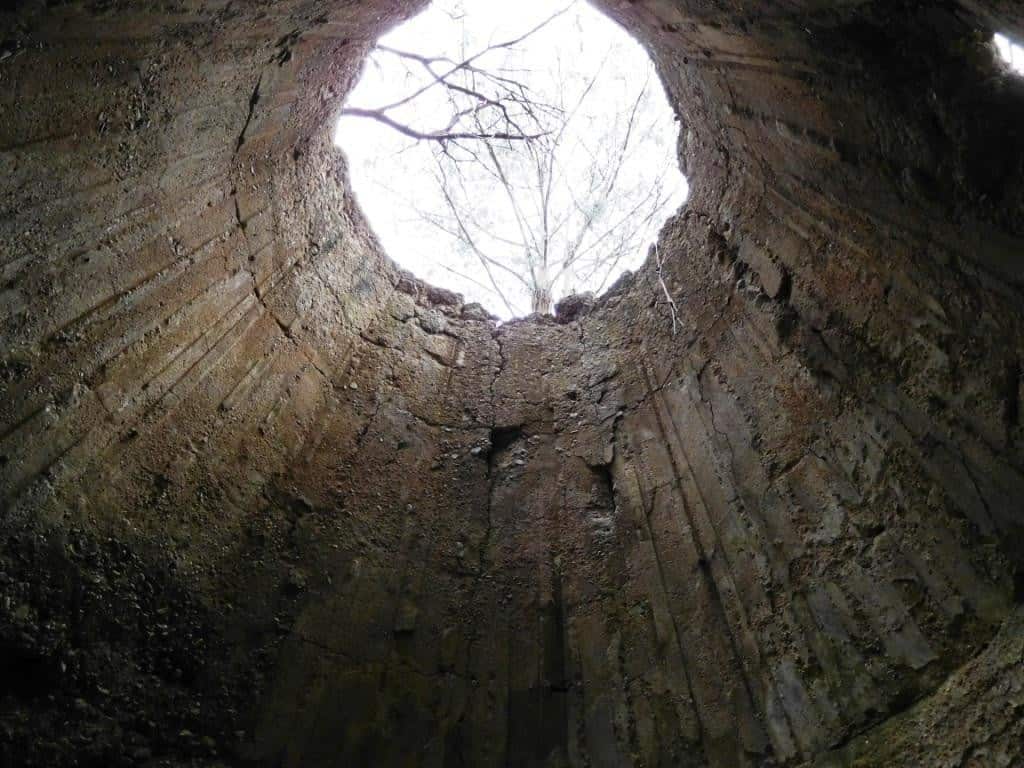From Caringal you can journey to Western Tyers via Morgans Mill Rd (open forest) or Buckle Spur, cool wet forest tree ferns and mountain ash. Probably 2-3 hours either way. There used to be a walking track along the river which followed the old railway line all the way to Growlers, but it has grown over (we checked). It was really beautiful. A job of clearing for someone, but maybe not me.
Pitmans Creek Track.
If you come down the Pitmans Creek Track from Buckle Spur you will first encounter Skinners camp just before you get to the river. It used to be a beautiful well-maintained camping area with toilets, barbecue facilities, shelter, information boards, etc. The Government seems to have abandoned it. You can still camp there though, or you can carefully cross the bridge and camp on the South side of the river. There are lots of blackberries and a few old fruit trees about, so you might get a feed – apart from the abundant trout and freshwater crays in the river. There are rabbits about in the blackberries too, so if you have brought your sling (http://www.theultralighthiker.com/how-to-make-a-sling/ – plenty of stones in the river) , you might be in luck!
Skinners camp.
The dogs managed the bridge – surely you can?
Camp South side.
As you cross the river to the South bank there is a river heights gauge on your left. It was just below .2 metres yesterday and the river quite canoeable. If you walk East along the riverbank reserve about 200 metres, after crossing a small rivulet you will come to the abandoned chimney of Morgan’s Mill which is on private land. There are two or three cottages about. It is worth a photo. https://en.wikipedia.org/wiki/Western_Tyers,_Victoria I believe there is a road easement through the two locked gates (you can step around them) on Morgan’s Mill Road linking it to Western Tyers Road if you came that way, also a steel government footbridge across the rivulet. The remaining cottages and ruins are what remain of the timber-getting settlement of Morgans Mill. After it was abandoned as forestry it became a strata-title commune for many years, something like the ‘New Australia’ in Paraguay. Shares might still be available. The remaining members (who must be in their 70s and 80s) clearly still visit infrequently.
Mill Chimney ruins.
Creates some interesting perspectives…
There are a number of other pleasant spots to camp every km or so as you make your way to the West along the Western Tyers Road towards the Christmas Creek campsite. Our family has spent many pleasant holidays camped along this stretch of river. We have canoed it many times from Palmers to Skinners, even all the way down from Growlers, just below which there is a Grade 4 rapid, so check it out first. I have continued down it as far as Delpretes Rd. It needs a lot of clearing, but would make a wonderful little wilderness river for canoeing all the way to Wirilda, perhaps nearly a week (by water) away.
Upstream from the bridge.
Downstream from the bridge. Note gauge.
A Note on Crays: These guys are not yabbies. As you can see they are as big as lobsters, and just as delicious! They are easily caught especially if you have some string and bait. Some spoiled meat or fish-heads perhaps. I would usually put out a number of baits along the river in likely spots (near logs, bank overhangs, deep holes, etc) tied to @ 2 metres of string (I find the coloured builder’s line easiest to spot). As you come back to check them you will notice you ‘have’ a cray if the string is taut. Slowly pull it towards you, being sure not to jerk it and frighten HIM off. (Lady crays with babies are always out of season). A trout landing net is handy for scooping him up, or you can pin him with a forked stick, then step into the river and pick him up behind the claws. Don’t let those claws bite: it is as bad as getting on the wrong side of a ferret! If you don’t have any bait or string you can still pin them with a forked stick. A pair of polarised sunglasses will help you spot them on the river bottom where they are greenish rather than the red which is their cooked colour. When you cook them, you only need to wait until they change colour. A couple of minutes at most. If you haven’t a billy large enough, you might need to kill them by plunging a knife through their brains, then breaking them into cookpot-sized pieces – or throw them on the hot coals for a couple of minutes. They are Della’s favourite food!
Typical Mountain Ash and Beech forest.
Much less typical, but strikingly beautiful plantation trees: Norfolks?
See also:
http://www.theultralighthiker.com/western-tyers-river-great-for-crays/
http://www.theultralighthiker.com/the-western-tyers/
http://www.finnsheep.com/THE%20UPPER%20YARRA%20WALKING%20TRACK.htm
http://www.theultralighthiker.com/upper-yarra-track-update-section-one-moe-yallourn-rail-trail/
http://www.theultralighthiker.com/upper-yarra-track-update-section-three-wirilda-to-moondarra/
http://www.theultralighthiker.com/upper-yarra-track-section-four-moondarra-to-erica/
http://www.theultralighthiker.com/upper-yarra-track-summary-cumulative-distancestimes/
http://www.theultralighthiker.com/upper-yarra-track-osheas-mill/
http://www.theultralighthiker.com/a-beautiful-world/
http://www.theultralighthiker.com/upper-yarra-track-winter-route-caringal-scout-camp-tyers-junction/














Hi there….when were you last here?
Must be a couple of years ago now. Why?
hi I was very interested in asking you a few questions about this particular piece of the planet. it would mean a lot to me.
Hi Sarah, Ask away.